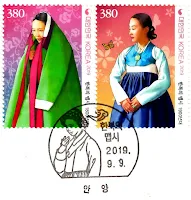KOREA POST on 9 September 2019 issued a set of four First Day Cover stamps on traditional Korean clothing or Hanbok fashion from 1500s till 1900s. Shin Jaeyong designed the stamps, whereas Southern Colour Print for POSA printed 672,000 stamps, using an Offset 4 Colour printing method. Each stamp carried a face value of 380 Korean Won.
Stamps designed included:
380 Korean Won - The 1500s Hanbok
380 Korean Won - The 1600s - 1700s Hanbok
380 Korean Won - The 1800s Hanbok
380 Korean Won - The 1900s Hanbok
The Style of Hanbok
380 Korean Won - The 1800s Hanbok
380 Korean Won - The 1900s Hanbok
The Style of Hanbok
Korea Post created this set of commemorative stamps to highlight the transformations in hanbok fashion between the 16th to 20th centuries.
Initially the hanbok style signified the wearer's social status in the 16th century. It was designed to impress, boasting both a great length and width, regardless of the wearer's physique. After the Japanese invaded Korea, the 17th century saw distinctively practical changes to the design of the hanbok. The Jeogori was narrowed and shortened so that it hovered above the waist of the Chima, which made it possible to produce more clothes with a lesser amount of material. In the later period of Joseon in the 19th century, through the reign of Yeongjo and Jeongjo, the design of the hanbok became more diversified while the basic structure consisted of a close-fitting Jeogori and a wide bottom with the shape of a bell. A Jang-ot, an outerwear worn by upper class women, acquired another use as the women began to wear it as a veil to cover their faces. On the other hand, in the 20th century, the types of Jeogori were simplified, and the length of Jeogori in the history of the hanbok. In fact, it was shortened to such an extent that there appeared an article in the Jeguk Sinmun that said "(women's) Jeogori should be lengthened so as not to reveal any flesh."
While the hanbok fashion has gone through a number of changes in keeping with the times, it is one of the only traditional attire in the world that has retained its fundamental structure.




No comments:
Post a Comment